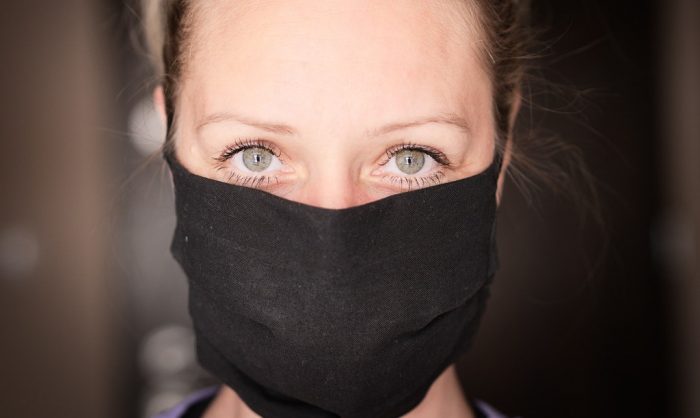It’s one of those perfect days when the sun is casting its brilliance and holding court in a crystal-blue sky.
The last hold of winter evaporates on my deck as spring is declaring its rightful, albeit late, place on the calendar.
It’s May, and it has been a long and strange transition from season to season. I am venturing out for my weekly grocery run.
I roll down the windows as Tom Petty’s “Free Fallin'” comes on the radio. I turn it up and embrace that amazing feeling of driving with the windows down for the first time in months, cool air on my face and all the promises of warm weather.
I pull into my grocery store with a peaceful feeling and a wide smile. I blissfully hop out of the car and soak in my surroundings—a worker with a mask on cleaning the carts off to my right, big signs screaming “Face Coverings Required Upon Entry,” and roped off areas ushering people away from doors once used as both exits and entrances, now closed off with arrows spaced six feet apart on the ground, funnel everyone into one entrance.
I am suddenly jolted back into reality.
I put my mask over my face, stifling my airway along with the unfettered joy I was experiencing, now replaced by anxiety rising within my body. The juxtaposition of these two extreme emotional states causing a small tsunami of upset inside my stomach.
I hate this new normal.
This reality of an unseen virus that is making people sick, killing over a 100,000 Americans and sweeping the world with its fears, dangers, and death. COVID-19 has radically altered the way we physically move in the world, and while that is certainly uncomfortable and odd, it is nothing compared to the impact it is having inside each and every one of us.
Anger, confusion, fear, anxiety, and uncertainty are consuming us on a daily basis as we learn to manage in these strange times. It is enough to throw the most emotionally stable person off balance.
The impact it is having on those who are already living in poverty, or those struggling with substance use disorders and mental health concerns, is one we are just slowly beginning to see unravel. While the headlines are dominated by the death tolls, the pathetic attempts to politically weaponized a pandemic, and the response or lack of response to the pandemic, there are smaller headlines that are being overlooked every day and many simply missing because the story isn’t being told.
The child who is starving at home because they no longer have access to childcare or school snacks and lunches.
The domestic violence victim who is forced to shelter in the home with her violent abuser, who on a good day comes home from work and begins his assaults, now must awaken to an even more angry and unemployed offender who is brutalizing her all day.
The little girl who was already enduring occasional rapes by her stepfather is now experiencing unthinkable daily sexual abuse, because her rapist is jobless and drunk 24/7 and she has no escape—no friend’s house, no daily school reprieve from the abuse where maybe a mandated reporter could pick up on a sign and attempt to intervene in the horror she is experiencing at home.
To the young man dealing with mental health who relied on the rigid structure of school, then practice, then work to get through his day is now faced with an empty calendar and days that blend into nights as he spirals without a sense of organization to his life.
To the newly sober person whose daily personal interactions with other recovering people, the warm smiles, the bad coffee, and the hugs that sustained him through the grueling days of early recovery and gave him the courage and resolve to not pick up another day are now shuttered as he attempts to access support online.
These are the stories we aren’t hearing enough about—but they are real. The hidden and slow turmoil that is brewing beneath the COVID-19 headlines. The daily emotional and psychological toll this pandemic is having on our society will not be fully realized for years—if ever. The trauma that every single human being is experiencing and absorbing is taking its toll in more ways than we can measure right now but will undoubtedly have long-term impacts.
It is not normal to be this isolated. As human beings, we require interaction, connection, and a sense of belonging to feel valued and supported. The longer the stay-at-home orders are in place, the more we need to turn our attention to these stories.
As social workers and those of us in the treatment professions, we need to be ready for the onslaught of admissions that will occur once we “open” back up. Many victim services, recovery centers, organizations, and agencies have begun to pivot around these challenging times. We are taking our services online. We are engaging clients differently.
Many agencies are reporting numbers of teens accessing services for the first time in numbers unseen before this national crisis. This makes sense as teenagers are accustomed to connecting online using apps and texting—it’s basically how they communicate in all endeavors.
But what about the smaller children and the elderly—our two most vulnerable populations—made even more isolated and at risk by the requirement of stay-at-home orders and restrictions in long-term care facilities and nursing homes, limiting access to everyday helpers and mandated reporters? Our health systems will need to take into account the impact of this time, as will our social service agencies. We must create trauma-informed responses in the aftermath of COVID-19 in order to facilitate healing and well-being.
Untreated trauma is all too often the underpinning of negative coping mechanisms such as substance use and abuse, acting out in children, truancy, self-harm, and suicidal ideation. We must be prepared for an emerging population that is collectively and individually traumatized by COVID-19, and those who were already in harm’s way and at risk will emerge with deeper emotional wounds and significant victimization.
Using trauma-informed approaches in all aspects of our health system and our social services will aid in compassionately guiding people toward resources that can help them heal. We must make sure those resources are there, that all staff are getting trained in what trauma looks like, and how to respond and intervene.
We must ensure we have enough accessible therapists, support groups, education, and peer-to-peer assistance as they are all proven to aid in healing. As staff are returning to work, there should be resources and information about trauma, signs, and symptoms to allow for a normalization of this new reality and also with referrals for treatment and assistance. As our children return to summer camps, child care, and schools, staff need to be vigilant in assessing for abuse and ensuring intervention is provided immediately. Conversations about the impact of trauma must begin at all levels of care, from hospitals to schools to corporate settings, nonprofit organizations, and governmental services.
If we do not start these conversations and begin to ensure these resources are available, the death toll from COVID-19 will continue to rise by way of suicides, overdoses, and homicides.









Read 0 comments and reply